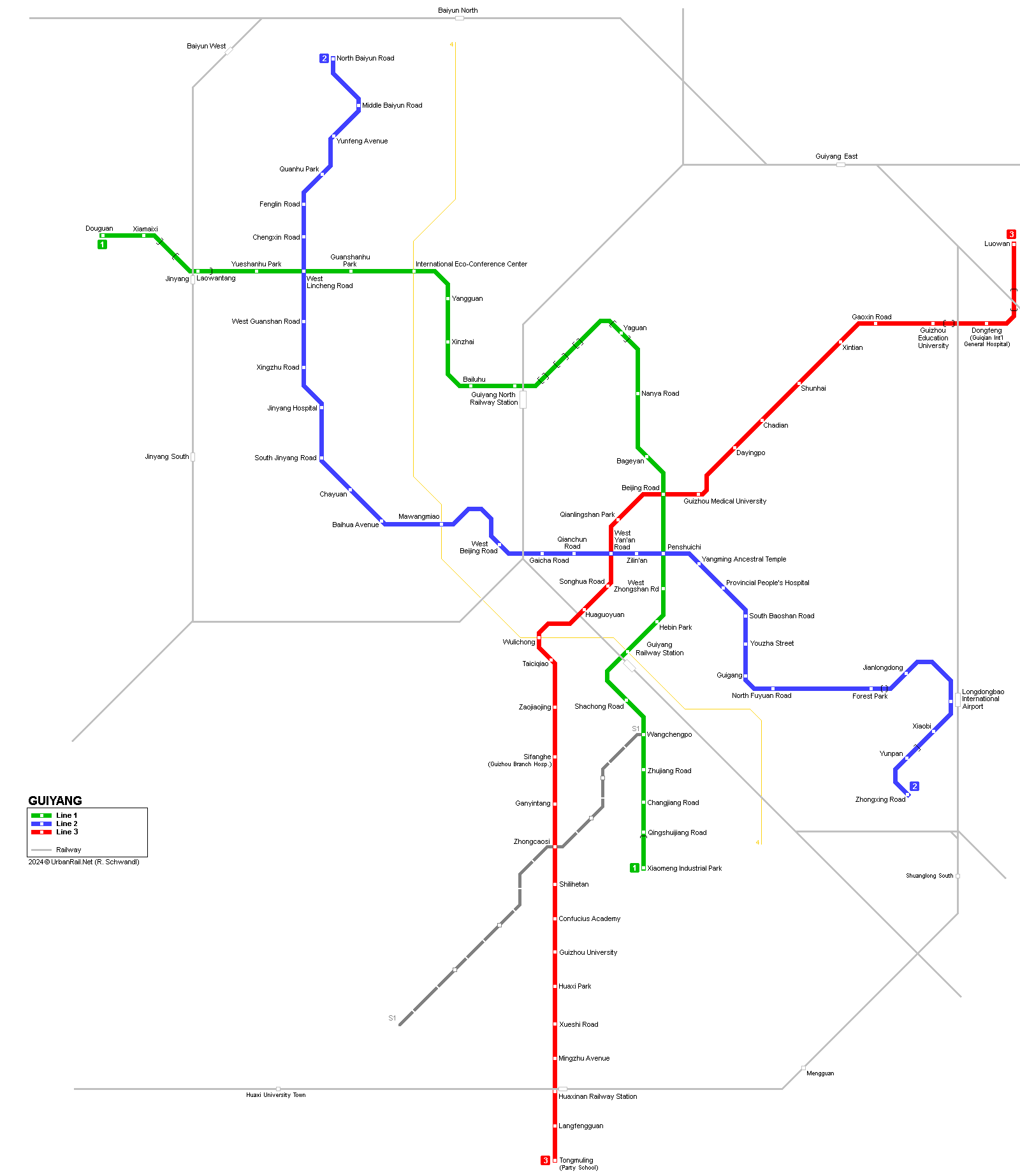
|
[ UrbanRail.Net ] [ Europe ] [ Americas ] [ Asia ] [ Africa ] [ Oceania ] [ News ] [ Books ] [ Links ] |
|
GUIYANG
|
| China |

|
GUIYANG
|
|
Guiyang, capital of Guizhou province of southwestern China, some 340 km south of Chongqing and 750 km northwest of Guangzhou; 3 million inhabitants in urban area.
|
|
Line
1
|
|
35.1 km, 24 stations 28
Dec 2017: Xiamaixi - Guiyang North Railway Station (12.9 km) |
|
|
|
Line
2
|
|
40.6 km, 32 stations 28
Apr 2021: North Baiyun Road – Zhongxing Road (40.6 km) |
|
|
|
Line
3
|
|
43 km, 29 stations 16
Dec 2023: Luowan - Tongmuling (43 km) |
|
Line
S1
|
|
28
Dec 2024: Wangchengpo - Zaojiaoba (30.3.km) |
|
Links
|
|
Guiyang Urban Rail Transit (Official Website) Guiyang Metro at Wikipedia
|
|
Report
|
|
Craig Moore's impressions in Jan 2018: Although construction of a medium-sized Metro system is underway, the new Guiyang Metro is currently operating only a 12.8km (11.1km underground) section in the northwest of the city, hosting 10 stations (8 underground). The line starts at the large Guiyang North Railway Station (Guiyangbei) which is the main station in the city for national high-speed rail services. The Metro station is below the main station and is linked to the large regional bus station, but signage across this huge space is poor and access to the Metro station is very confusing. Once in the ticket hall, there is an immediate familiarity, with the layout and signage similar to most other systems in China - a high sheen, rectangular structure with ticket machines on end walls, Customer Service Centre, security scanning and entrance barriers at the ends and centre of the space. Escalators, lifts and stairs lead to the platforms. These are again similar to most in China, with full screens of tinted glass, topped with strip map (green) and station name, pillars and stair walls with station name in bold calligraphic style and Pinyin, RTI screens, toilets and limited seating. The large beige tiling and white pillars give the platforms a light and spacious feel, although this might well be down to the fact that passengers are few and the stations are deserted. From Guiyangbei to Yangguan the island platforms are similar in appearance, but from IECC, stations have side platforms with entry and exit barriers directly at platform level. Beyond Yueshanhu Park there is a long incline to the elevated section. Most of the elevated section is housed in noise-reduction barriers, but passengers can still glimpse the mountainous feel to the city – there is little population in these parts of town. Laowantang is the nicest station on the system with a high arched roof, side platforms with half screens, hanging boards with green strip map and RTI. The ground-level ticket hall is of interest with a glazed semi-circular entrance at either side of the station. A further tunnel brings the line to its current terminus at Xiamaxi. This has an island platform with a huge wall at the south side filled with hanging fauna which will form a pleasant border once matured. To the west, the tracks continue to the Douguan extension with two additional middle tracks acting as a stub for the current terminus. Services run from 0630-2200 and have 8min base headways. The line takes 21mins to traverse, and would be shorter if the long dwell times at stations could be reduced. The CRRC B type stock is formed of 6 cars with DC 1500 V overhead catenary power supply. The stock is white with a broad black window band being bordered by green stripes near the roof and below the window. The frontage has a streamlined look with a black, green and white scheme as well as the green logo. The interior is very clean with bold green side seating, low green grab handles and the austere staggered schematic map. Above the doors there are dynamic LCD strip maps which offer different levels of information as the train progresses between stations, and all information is in Mandarin and English. Unlike other services in the city, the Metro only uses the two languages and not Miao script/language. With Miao being the main ethnic group in the region (Guizhou has the largest concentration of Miao in China) I was surprised by this as other systems use different scripts and languages. All maps and audio announcements have been future-proofed, with maps showing the full line (to be completed by late 2018) and audio information claiming the service is bound for Xiaomen Industrial Park. Tickets come in card form which are tapped on entry and fares are distance based, ranging from 2-5 Yuan. Hard-copy information is available at the moment but this mainly comprises a ‘how to use’ guide. Staff are very friendly but in most cases there are more of them than passengers. The Guiyang Metro is in its infancy so it is difficult to judge it at the moment, but it is smart and efficient, without any of the flair sometimes found on new systems.
|
|
Photos
|
2015 © Robert Schwandl (UrbanRail.Net)